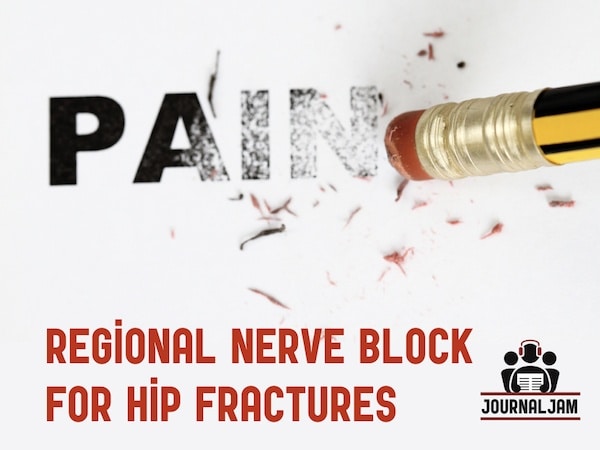Pain management is all the rage these days with the opioid epidemic still in full swing. While we shouldn’t expect zero pain in all our ED patients, oligoanalgesia is still a problem in the ED, especially in older patients. On the other hand, hammering an 87 year old with multiple doses of morphine or hydromorphone until they get their hip fracture fixed in 24 or 48 hours is a ticket to delirium, which carries a surprisingly high in-hospital morbidity and mortality. NSAIDs and acetominophen that we might use for long bone fractures that can be immobilized easily probably aren’t gonna cut it. We’ve all seen the patient with a broken hip who hits the ceiling in pain with even the slightest adjustment of their position on the stretcher. So instead of giving opioids for the little old lady with a hip fracture, why not perform a regional nerve block? In this EM Cases Journal Jam podcast with Anton Helman, Justin Morgenstern, Rory Spiegel, and special guest Jacques Lee we explore the evidence for femoral nerve blocks and fascia iliaca blocks as well as discuss the practical implementation of them in your ED. We answer questions such as: Do regional nerve blocks for hip fractures effectively reduce pain? Do they decrease opioid use? Are they safe compared to standard pain management? Should the block be done prior to x-ray confirmation? and many more…
Podcast production by Anton Helman, Justin Morgenstern and Rory Spiegel.
Editing and sound design by Anton Helman. EBM bomb by Anton Nicoline.
Cite this podcast as: Helman, A, Morgenstern, J, Spiegel, R, Lee, J. Regional Nerve Blocks for Hip Fractures. Emergency Medicine Cases. August, 2018. https://emergencymedicinecases.com/regional-nerve-blocks-hip-fractures/. Accessed [date].
Rare complications of regional hip nerve blocks
Local Anesthetic Systemic Toxicity (LAST) is the result of enough local anesthetic being absorbed systemically that central neurological and cardiac effects are observed. LAST is thankfully very rare (between 8 and 30 in 100,000). Most commonly this occurs when the anesthetic is accidentally injected directly into the circulation as a result of sodium channel blockade. It also can occur with large doses deposited at the target site that is then absorbed into the circulation. Symptoms include perioral numbness anesthesias, restlessness, tinnitus progressing to seizures, hypotension and cardiac arrest. Point of Care Ultrasound (POCUS) to guide the injection reduces the risk of LAST.
Nerve damage has been reported to occur in only 2-30/100,000 femoral nerve blocks with most of the resulting symptoms resolving over several months.
Tips to minimize complications of regional nerve blocks for hip fractures
- Use POCUS to visualize needle tip at all times, if the needle tip is lost – stop advancing and find it or start over.
- Aspirate before injecting to ensure that you’re not in the artery.
- Have an assistant with you. While you hold the probe and needle, the assistant can aspirate and adjust buttons on the POCUS machine.
- In addition to documenting the procedure well, write the time and date on the patient’s leg to ensure that after the patient goes upstairs they don’t do a second block.
- Have intralipid therapy available nearby in the rare event that you inject a big bolus of bupivicaine or ropivacaine into the circulation.
The best review article on regional nerve blocks for hip fracture looked at 9 RCTs and showed that regional hip nerve blocks were equal or superior in reducing pain scores compared to standard therapy, required less opioids use, and led to no life threatening complications, with some increase in minor complications.
Ritcey B, Pageau P, Woo MY, Perry JJ. Regional Nerve Blocks For Hip and Femoral Neck Fractures in the Emergency Department: A Systematic Review. CJEM. 2016; 18(1):37-47.
Procedural guides on regional nerve block for hip fracture
EM Ottawa video on ultrasound guided femoral nerve block
NYSORA shows POCUS guided hip block procedure
For details on a regional nerve block kit for hip fractures designed by Dr. Jacuqes Lee email him at Jacques.Lee@sunnybrook.ca
Justin’s deep dive into the literature on regional nerve blocks for hip fractures on First10EM.
Drs. Helman, Lee, Morgenstern and Spiegel have no conflicts of interest to declare





[…] As in rib fracture ED management, it is prudent to employ early analgesia and/or regional anesthesia such as femoral nerve block/fascia iliaca block. […]